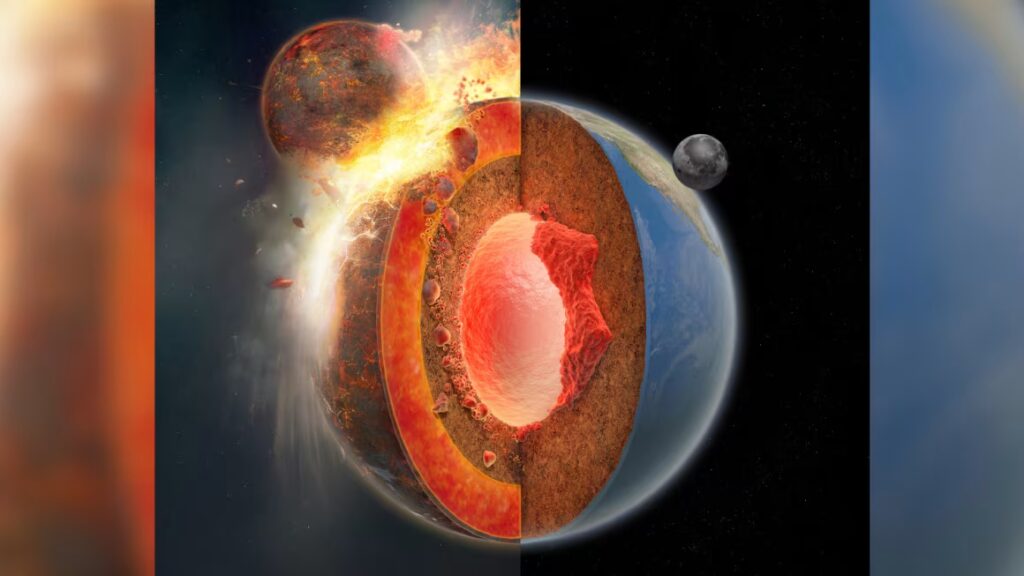 Portions of the moon-forming impactor Theia survived throughout Earth’s history in the deep mantle while others went on to form the Moon. Credit: CNN World.
Portions of the moon-forming impactor Theia survived throughout Earth’s history in the deep mantle while others went on to form the Moon. Credit: CNN World.
About 4.5 billion years ago, Earth had a violent neighbor. A young, still-forming planet named Theia slammed into our world with enough force to melt vast portions of its mantle and scatter a huge amount of debris into orbit. This molten debris would eventually coalesce into the Moon we know today.
Theia itself didn’t survive the impact, but new evidence suggests that it wasn’t some distant wanderer from the outer solar system. It was our next-door neighbor.
The Cosmic Autopsy
Researchers from the Max Planck Institute for Solar System Research (MPS) and the University of Chicago have pieced together the most detailed reconstruction yet of Theia’s chemical makeup and origin. Their conclusion: Theia likely formed closer to the sun than Earth did.
“The composition of a body archives its entire history of formation, including its place of origin,” said Thorsten Kleine, director at MPS and a co-author of the study.
The researchers examined the isotopes of certain key metals — particularly iron, molybdenum, and zirconium — in both terrestrial and lunar rocks. Isotopes are different versions of an element, distinguished by the number of neutrons in their nuclei. In the early solar system, these isotopes weren’t evenly distributed; they varied depending on how far from the sun a planet formed. That variation makes them a kind of chemical geolocation metatag.
Using samples from 15 Earth rocks and six moon rocks collected by Apollo astronauts, the team measured isotope ratios with extraordinary precision. They found that the Earth and the moon share nearly identical isotopic compositions. That’s no surprise, as earlier analyses of chromium, calcium, and titanium had hinted at the same thing.
But it deepens the mystery of the moon’s birth. If the moon formed largely from Theia’s debris, why does it look so chemically identical to Earth?
Reverse Engineering a Lost Planet
To find out, the scientists turned to a kind of planetary reverse engineering. By calculating which mixtures of elements could produce today’s isotopic signatures in Earth and the moon, they worked backward to deduce what Theia must have been made of.
“These elements have different affinities for metal and therefore partition into planetary mantles in different proportions; this is why gold is so rare and precious!” explained planetary scientist Nicolas Dauphas of the University of Chicago and the University of Hong Kong. “They give us access to different phases of planetary formation.”
Earth’s iron core formed early, drawing down metals like iron and molybdenum. Yet both elements remain in the mantle today, meaning they must have arrived later — likely delivered by Theia. The isotopic evidence suggests that Theia was a rocky planet with a metallic core, about 5 to 10 percent of Earth’s mass, formed in the inner solar system.
“The most convincing scenario is that most of the building blocks of Earth and Theia originated in the inner solar system. Earth and Theia are likely to have been neighbors,” said Timo Hopp, lead author of the study.
Theia wasn’t a rogue object from deep space, as previously assumed. It was a sibling world, assembled from the same solar dust and metal-rich debris that built Earth. Then fate — or better said physics — brought the two together in a collision that remade them both.
A Shared Origin, A Divergent Destiny
The idea of a giant impact forming the moon dates back to the 1970s in order to explain why Earth and the moon’s compositions are nearly indistinguishable. If the moon were mostly made of Theia’s material, it should look different. If it were mostly made of Earth’s mantle, it shouldn’t have enough iron.
The new study shows that both planets were born from nearly the same region of the solar system, which explains why their chemical signatures match so closely. It also suggests that the moon inherited both Earth’s and Theia’s materials, thoroughly mixed in the fiery aftermath of the collision.
Thorsten Kleine called the team’s work a “reverse engineering of a planet.” By integrating isotope data with meteorite comparisons, the scientists reconstructed Theia’s “list of ingredients” and traced its probable birthplace to a zone even closer to the sun than Mercury and Venus once orbited.
Back in 2020, Kleine’s group showed that celestial bodies forming near the sun tend to be richer in heavy elements like molybdenum. Earth’s mantle, in fact, contains a bit more molybdenum and zirconium than models predict it should. Those excesses, the team now argues, came from Theia.
Theia’s collision didn’t just sculpt the moon; it reshaped Earth itself. The impact may have altered our planet’s tilt, seeded its mantle with vital metals, and stabilized its orbit. Without that cosmic accident, Earth might not have developed the long-term climate stability that allowed life to evolve.
The findings were reported in the journal Science.
